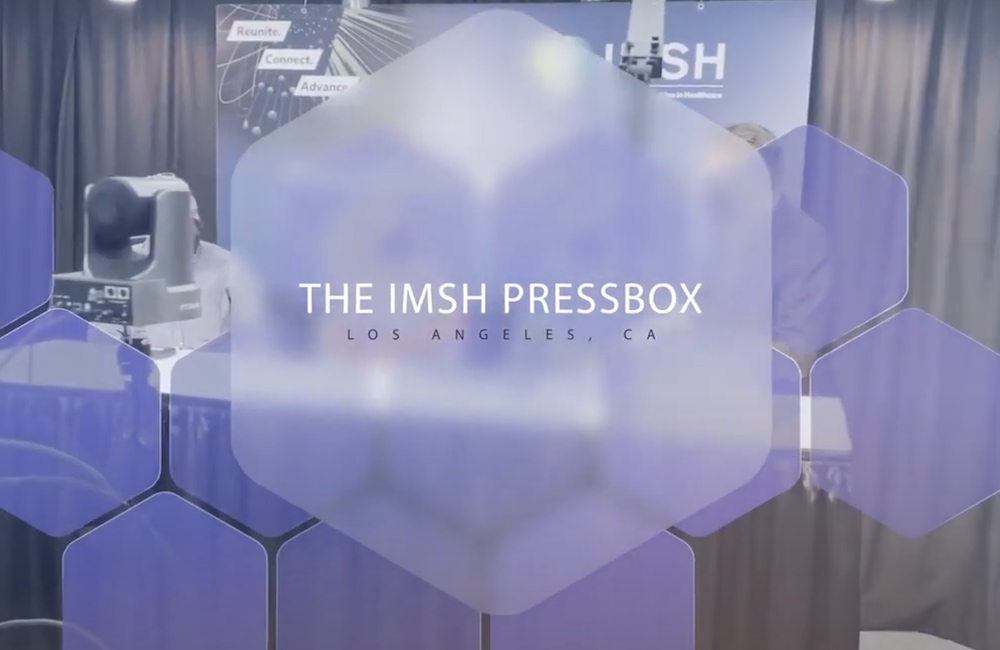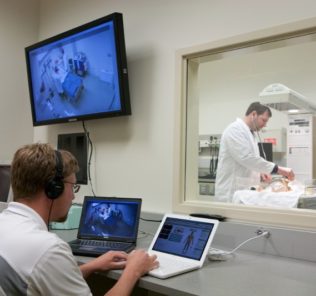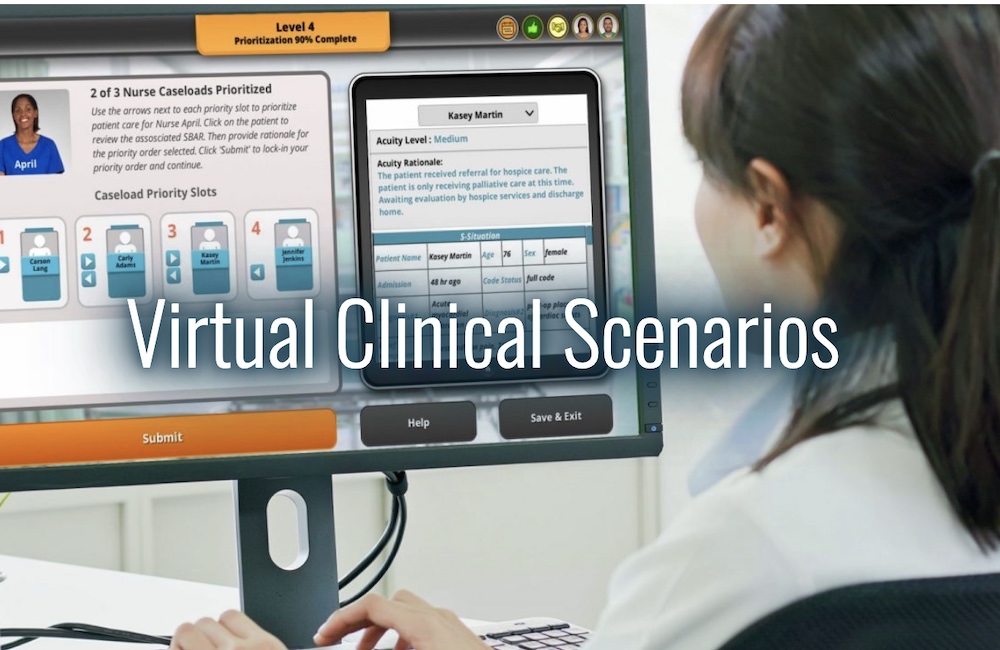IMSH 2022 PressBox: COVID-19 Insights from Healthcare Simulation Industry Experts
During IMSH 2022, HealthySimulation.com and the Society for Simulation in Healthcare (SSiH) had the exciting opportunity to interview leaders from across the clinical simulation industry on a variety of topics. One such topic, COVID-19, was top-of-mind given this winter’s Omicron variant surge. Sharing their insights on how the pandemic has impacted their healthcare simulation companies, and industry as a whole, Lynn Welch, EMS Vice President, Business Development and Marketing, and Amar Patel, CAE Chief Learning Officer, along with HealthySimulation.com CEO and Founder Lance Baily provided a unique perspective. This article shares their conversation in hopes that it will spark similar conversations within medical simulation centers, institutions, and facilities worldwide.
Throughout this interview, the clinical simulation leaders relay what they have witnessed in the healthcare simulation industry since the onset of COVID-19. Yet first, Baily notes that a recent COVID-19 healthcare simulation survey conducted by HealthySimulation.com demonstrated that many simulationists believe investments they’ve made in distance and remote learning technologies or other tech simulation technologies to overcome pandemic-related challenges have made an impact and promoted program awareness. Read part of the IMSH 2022 PressBox interview below the full video here:
More About the PressBox at IMSH 2022
Sponsored Content:
Lynn Welch: We were in a very interesting position in March of 2020. In 2019, we saw that so much of our client base was migrating towards telehealth because their students graduating were going on to be practicing telehealth. We had a telehealth workflow on our platform already. What we had the opportunity to do was a partner with our clients to really understand what that looked like when an entire program is now telehealth, and what do we had to add quickly, tweaking some of the workflows so that it was a more experience-rich environment.
We were fortunate that we already had the telehealth baseline. We were able to move very quickly. I remember the first month that things were shut down, nobody had a day off, but we were just fascinated with what we were doing because it was changing so fast. We were on the phone on weekends with our clients, testing workflows, pushing out new products and innovations, and then seeing them put into use immediately. In my career in simulation, which started on the military side in the immersive gaming world, I spent time with a lot of the early first generation of the Microsoft Xbox that was funded by DARPA.
I was one of the beta testers at a government think tank I worked at. Ever since that time, I have had the opportunity to be immersed in the cutting edge of innovation. I feel very fortunate that I’ve had two runs at that in my career because most people don’t get that opportunity. I feel that the innovation that’s happened is being driven by COVID. It’s an unfortunate prompter of technology leaps, but what our industry did as a whole, I found remarkable.
I know we had well over a hundred thousand hours now in the virtual simulation that we delivered. I know Amar, your company was right in there too, doing something very similar. So I think about where we are today. It would’ve taken us five to 10 years to get there. It’s just amazing what our community can do as a whole.
Sponsored Content:
I was getting calls from everybody, and we were all talking about what are we to do? How can we move it forward? We’ve got to keep students moving forward. We cannot have a gap in healthcare providers coming out of schools. We’ll still be unpacking where some of the gaps were because surely there are some. I just think it’s amazing what we’ve been able to do.
Lance Baily: I really think that COVID, as unfortunate as it has been, has been a catalyst for our industry in terms of global awareness and the need for education and training under dire conditions. This is true in the healthcare setting, and for those that are considering being prepared for the next pandemic. I think every government body, hospital, school, local state, and national leadership will make plans for this in the future – making sure that they’re gonna be better prepared for the next one.
I also think that as we see the results, it’s making an impression in terms of what simulation can do. I think that that has lasting effects beyond COVID and beyond a pandemic. This is going to have an impact on our industry as a whole. Amar, what has CAE healthcare seen in the past two years and how did the company respond to this crazy time?
Amar Patel: The biggest change that existed was the changes in where education and training are built. When we think about hospital systems shifting and adjusting in real-time, we saw moves from where live simulation experiences happen to incite to experiences. People were doing hand hygiene training and PPE education, and you would think that’s the core of healthcare in general. We do it every day, but why are we having to retrain so many providers in real-time?
At the same time, the academic environment certainly shifted. They moved to a virtual experience almost instantaneously. Individuals had to figure out how to do curriculum and content in a virtual world so that it was just an easy pivot. Eight hours of classroom is eight hours online. We all know in reality, eight hours on zoom is a brutal, brutal thing for a learner. It’s very difficult for your kids who are having to shift, and it’s difficult for adults to make that change.
Lance Baily: I wonder how much of it could be done virtually without all those additional, extra pressures that life forced upon all of us in a lot of different ways? How did CAE find that transition for its clientele once they were able to get into an online space? Was that a challenge for them? Or was that something that they were able to actually quickly adopt? The reason I’m asking is that, on the technology adoption scale, we have these laggards, we have these late majority people. They’re not gonna get involved until they absolutely have to. Is it because they’re uncomfortable or is it because they’re just resistant? So what was that transition period like in terms of CAE’s perspective?
Amar Patel: For individuals. One of the things that we certainly did is ramp up pretty hard and fast with leveraging adaptive learning education modules and hit and seeing the entire audiovisual systems experience to allow for better remote learning experiences – tying multiple pieces of technology together to Lynn’s point. It’s important to make sure that learners have a single system and have access in a single unified way.
We had competency-based education in a live environment. How do you do competency in a virtual world? How do you measure performance in healthcare, especially where it’s skills-based evaluations? How are you measuring the performance of an individual for success? The question we have and ultimately answered is: we had a lot of fourth-year nursing students or fourth-year medical students graduate in a virtual world. What is the impact that has?
We really believed in the fact of utilizing adaptive education to drive competency effectiveness and efficiency. Let the student create their own journey. Stop dictating the journey from a teacher’s perspective, but students and learning really focus on that. To be able to do that – launching online modules – mechanical ventilation was probably the biggest thing two years ago.
We invested pretty hard and made sure we created an adaptive ecosystem for our learners. We provided scenarios in education so that those can be utilized in a virtual world. The big question ultimately is, did it make an impact in the quality and safety metrics for individuals that were trained in a virtual world in their last year of school? I don’t think we know the answer to that question yet. I think we’re still learning it. We are starting to see normalization as we think about the two-year curve, where a lot of the focus is across (whether it’s industry collectively or us as an organization) has been, as we saw, in person at a high rate, we saw virtual at a high rate.
Now we’re starting to see the middle, as it starts to center itself a little bit, where the hybrid is really here to stay. People said hybridization would never be a sticking point, and what we’re seeing is that normalization. We’re also seeing the utilization of adaptive education, whether it’s mixed reality or virtual. Sitting here at an IMSH, we’re seeing a lot of organizations that have virtual reality education and training, right? We are certainly pushing hard and pushing fast and furious into that as well because we believe that to be the future.
When I think about cost impact and knowledge retention of a learner, it isn’t discussion boards. How many of us have had effective discussion boards that you actually retain something. Where are mixed immersive simulation experiences? The physical body is never going away.
Lance Baily: It’s like we’ve got a learning pyramid and here’s your top apex would be and your high fidelity simulation lab experiences. Now we’re adding this whole other layer that really didn’t exist five years ago of digital-based learning technologies. I really like what you said with regards to the concept of non-linear learning. Now we have the ability for learners to come in, and in a sense, choose their own adventure of how they want to go through the learning.
The thing is that some learners might be comfortable with skipping chapter four, starting there doing all that work. You’re still gonna need to show competencies in all those other areas. That functionality and those features are really important for educators. To me, it seems like for both companies, it’s been an opportunity to dive deep into those tools and come away with more learning about how they can be effective, utilized now and in the future.
In the past six months, have you seen groups still really active in those digital learning technologies? Or is it a quick switch back over,? Is the digital-based stuff still remaining to be an important part of that educational piece?
Lynn Welch: From our perspective, we’re seeing the hybrid here to stay. I agree with Amar entirely here that it’s here to stay. It gives programs a lot more flexibility. It gives students a say in guiding and directing their own learning and their pace of learning – which is very important. The other piece we didn’t touch on that I think very important is that we saw a lot of larger healthcare systems embrace this as a way to truly solve the just-in-time learning issue. For example, we work with a behavioral healthcare system staff, and they adapted to what they had planned to have live simulation centers up and running, went to complete virtual.
They deployed two main courses that were very much focused on some of the mental health challenges that COVID has been driving and the increased risk of suicide. For example, they have 5,000 clinicians, they are trying to train on a new methodology. They were very quick to deploy a hybrid approach that had them learning the new didactic modalities online. Then there was a live simulation, virtual simulation component of that. They were immediately going into practice, and at the same time, they were a driver of having the long-term waiver for telehealth reimbursement push forward legislatively.
They were training their staff in a hybrid environment and a fully virtual environment. They were training them on how to practice and deliver telehealth. One of the things they saw all during COVID, as they started rolling these courses out and they started delivering the telehealth model, they found that their patients had a 90% improvement in outcomes. For a 10 week series of treatments, they found patients because of the telehealth model, which was built on a similar technology backbone – they were participating. They were finishing courses of treatment and there were better outcomes.
If you look at where we have been historical with the adoption and trying to challenge with just-in-time training, are we ready for the next public health issue? Are we ready for the next pandemic? Do we know how to scale that training up rapidly? This was a great learning model to understand, yes we can. The advances that have been both on the education and on the delivery side will continue to accelerate us and make us better prepared for the next major event.
The Society for Simulation in Healthcare (SSH) hosts IMSH annually and offers over 250 sessions encompassing interactive and immersive courses and plenary sessions. The IMSH meeting is aligned with the SSH’s mission to “provide hands-on learning in leading-edge medical simulation trends and technology, networking and collaboration.” Furthermore, the programs are all peer-reviewed and are selected to serve the needs of novices to experts. For the first year ever, HealthySimulation.com partnered with SSH to provide the PressBox — a digitally recorded event with exclusive interviews, panel discussions, and presentations that highlight healthcare simulation champions, industry-wide trends, and must-know knowledge!
HealthySimulation.com Founder / CEO Lance Baily said that “the PressBox, produced by myself and SSH Marketing Director Curtis Kitchen, was an opportunity to dig deeper into global trends of healthcare simulation with leading experts, not only from academia but from the vendor community as well. We at HealthySimulation.com are thrilled to work with SSH and IMSH leadership to find more ways we can leverage digital media production to expand the conversation surrounding simulation, especially in streaming-based content. We look forward to expanding these conversations and production opportunities at IMSH 2023 and beyond!”
Stay tuned to HealthySimulation.com for more PressBox content including a look at how XR technologies are revolutionizing clinical education, a check-in with simulation non-profit organizational leadership from around the world, discussions regarding the transformation of the simulation space since the COVID began, and much more! You can also start to see some of our Vendor recaps from the exhibit showroom floor here:
IMSH Vendor Demo Videos:
- IMSH 2022 Vendor Demos: EMS, Sentinel U, Echo Healthcare, Health Scholars
- IMSH 2022 Vendor Demos: CAE Healthcare, Avkin, EMS
- Impacts of COVID on Healthcare Simulation Global Survey Results
Check Out These Additional Healthcare Simulation COVID-19 Resources
Lance Baily, BA, EMT-B, is the Founder & CEO of HealthySimulation.com, which he started while serving as the Director of the Nevada System of Higher Education’s Clinical Simulation Center of Las Vegas back in 2010. Lance is also the Founder and acting Advisor to the Board of SimGHOSTS.org, the world’s only non-profit organization dedicated to supporting professionals operating healthcare simulation technologies. His co-edited Book: “Comprehensive Healthcare Simulation: Operations, Technology, and Innovative Practice” is cited as a key source for professional certification in the industry. Lance’s background also includes serving as a Simulation Technology Specialist for the LA Community College District, EMS fire fighting, Hollywood movie production, rescue diving, and global travel. He and his wife Abigail Baily, PhD live in Las Vegas, Nevada with their two amazing daughters.
Sponsored Content:




















